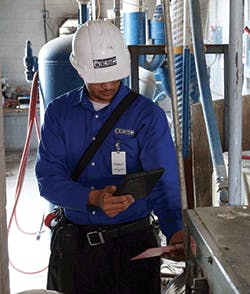Safety always is the No. 1 concern in any work environment with hazardous machinery. The power sources for any hazardous energy source must be accessible and clearly identified as the correct choice for the equipment to be serviced. This is the very essence of why lockout/tagout procedures were developed.
While most managers realize that lockout/tagout has remained in the Top 10 most-cited regulations year after year, they often fail to recognize how their own company also might be as negligent as the companies involved in the startling statistics. In fact, if you’re reading this and you haven’t taken a hard look at your lockout/tagout program in the last 2 years, you can assume you are in the same boat.
Commonly Overlooked and Misunderstood Components
The first misunderstood component of lockout/tagout is the most basic: the "procedure" itself. Employers often believe they can get by without machine-specific lockout/tagout procedures for each piece, or without having any procedures at all. There’s a common, mistaken belief that as long as the employee is familiar enough with the equipment, nothing bad can happen.
Many companies believe that simple equipment, such as exhaust fans, grinders, drill presses and the like do not require machine-specific procedures. To be exempt from having a machine-specific procedure, a given machine must meet eight criteria set by OSHA in CFR 1910.147(c)(4)(i), meaning that the vast majority of equipment definitely will need its own procedure.
So how much is "vast majority?" Assume 90 percent or more of all your equipment and you’ll be close; 95 percent or more and you’re closer. Remember, non-lockable energy such as kinetic and gravity count as secondary sources.
Another important and overlooked aspect is failing to consistently audit and update employee training and lockout/tagout procedures. When any part of the equipment or layout changes, the procedures and associated employee training must be evaluated and updated as necessary. Businesses often try to save costs by keeping the same system in place, year after year, even as employees and equipment change, leaving their lockout/tagout procedures woefully out of date.
Circling back to the most commonly overlooked aspect of lockout-tagout – the procedures themselves.
Most-Likely Deficiencies
The most-obvious way in which businesses are deficient is an attitude that says, "Preventing these accidents would be cost-prohibitive." This demonstrably is false.
Lockout/tagout violations consistently are in the list of the 10 most-cited regulations by OSHA every year. Businesses who try to cut costs by skimping on safety with lockout/tagout are inviting disaster, in more ways than one. The important thing to remember is that when neglecting lockout/tagout procedures, it's not an accident; it's an incident. When something is 100 percent preventable by the use of established rules and equipment, it is no accident when it happens. Incidents are completely predictable and completely preventable.
Myth: Compliance Is Too Expensive
Most companies gravely underestimate their risk, as well as their uncaptured efficiency with lockout/tagout. Let me explain:
If a company has 100 machines and no lockout/tagout program, then they are exposed to more than $7 million in potential OSHA fines. However, that is the least of our concerns. If a preventable fatality occurs, fines typically are negligible compared to the inevitable civil lawsuits that ensue that easily can surpass $10 million. In fact, legal settlements that have been published are on average 50 times the associated fine amounts or more. And as far as total cost to business, the culture shock and PR damage may be a deathblow to the entire business, sending ripples through all the employees’ families including, most importantly, the victim’s surviving family.
The civil lawsuits from the victims and victims’ families often are settled out of court for undisclosed amounts, making them less likely to serve as a warning to other businesses, but they still are very real and estimated to cost businesses nearly $1 billion annually for lockout/tagout-related accidents alone.
Compliance Is Your Biggest Strength (and Weakness)
There’s an extreme cost of which most companies are not aware when neglecting to be compliant with lockout/tagout. That cost is lawsuits and the resulting brand damage. They are far more costly and have the chance to be a true deathblow to even large businesses. Let’s take a look:
Total estimated lockout/tagout accident costs to industry with OSHA fines and lawsuits*:
- Lockout/tagout fines 2013 – Approximately $14 million (federal and state stats combined)
- Settlement Estimates – ($14 million x 50 = $700 million)
- Downtime and Damage to Equipment/Property = $28 million
- Insurance Annual Premium Increase = $70 million
So, while the industry thinks that the total penalty is $14 million in lockout/tagout fines from OSHA, the reality is that it’s closer to $800 million and that doesn’t include brand damage and PR disasters that easily could double or triple that number if it was calculable.
The Real Driving Force
In the end though, whether the amount is $14 million or $800 million in annual risk avoidance, the people are who matter most. No respectable manager or business owner wants their profits stained with blood, nor do they want to bear the burden of knowing they could have done something to avoid a catastrophic incident.
A Bureau of Labor Statistics study showed that 80 percent of the workers surveyed failed to even turn off equipment before performing service work. Why? Because that was the "easiest way."
While it’s difficult to place a value on an accident you won’t have because of the upgraded program, there is one way to value the upgrade that is very real and very calculable – new-found efficiency.
On average, a modern lockout/tagout program will save 80 cents to every dollar invested to put it in place. And that savings rolls in year after year.
If a company invests $100,000 to modernize their lockout/tagout program, they can expect real-world savings of $80,000 in year one, two, three and so on. Here are the three biggest contributors to efficiently gains:
- Annual procedure auditing can be conducted up to 80 percent more efficiently.
- Annual employee auditing can be completed 80 percent more efficiently.
- Daily lockouts can be executed 50 percent more efficiently.
This leads to less downtime and increases productivity system wide anywhere from 2 percent to 7 percent.
And lockout/tagout is only the beginning. When you think of servicing equipment, a truly modern program will weave the message of arc flash, confined spaces, standard operating procedures and machine guarding into one seamless solution that delivers business risk avoidance and business competitive efficiency. And that’s going to save lives and money every day.
Jimi Michalscheck is the CEO of ESC Services Inc., the world’s largest engineering firm dedicated to lockout tagout services. For more industry best practices surrounding lockout/tagout, visit https://www.escservices.com/learning-center.

